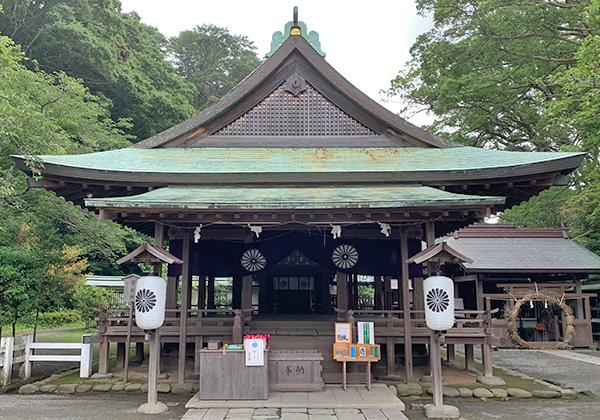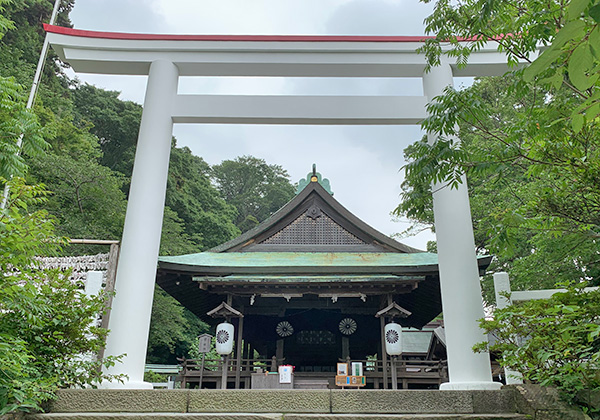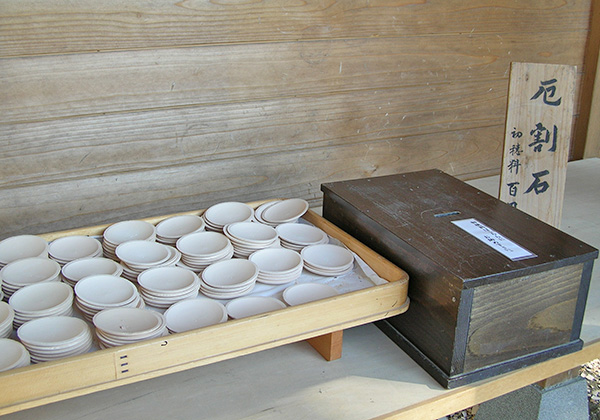Kamakura-gu
| Official Name | Kamakura-gu. Also called Oto-no-miya {oh-toh-no-me-yah} or Daito-no-miya {dye-toh-no-miya} |
|---|---|
| Religious sect | Shinto |
| Founded | in 1869 by Emperor Meiji {may-gee} |
| Founding priest | Gyo-yu Taiko {gyo-you tie-koh} |
| Main object of worship | Spirit of Prince Morinaga {mo-re-nah-gah} |
| Address | 154 Nikaido, Kamakura, Kanagawa 248-0002 (show route from current location ) |
| Location | 1,600 meters northeast of Kamakura Station |
| Time needed to get there | 25 minutes |
| Admission | Free (open yard) |
| Phone number | 0467-22-0318 |
| Restrooms | Available |
Historical Overview
Though the Shrine is considerably new, it was erected to the spirit of Prince Morinaga (1308-1335), probably the third child of Emperor Godaigo {go-dye-go} (1288-1339). "Probably" is because Emperor Godaigo had a wife and 17 court ladies giving birth to 18 sons and 18 daughters, and the record does not clarify exactly when the Prince was born. In addition, his mother gave a birth to a child by his grand father. The Prince's full name is Oto-no-miya Morinaga, hence the Shrine's alias is "Oto-no-miya". He grew up at a chaotic time the Kamakura regime was about to end.
It was back in 1333, the year the Kamakura Shogunate terminated and the ruling power was temporarily handed over to Emperor Godaigo. The Imperial Court finally restored the sovereignty as a ruler of Japan. However, his regime did not long last. Takauji Ashikaga {tah-kah-woo-gee ah-she-kah-gah} (1305-1358), the founder of the Ashikaga Shogunate, first sided with the Emperor and helped him to win the battle against the Hojos in Kamakura, but changed sides suddenly and tried to establish his own government betraying the Emperor. Knowing the movement, Prince Morinaga braced himself against the Ashikagas but to no avail. He was captured and sent to Kamakura, where he was under house-arrest at Tokoji {toh-koh-gee}, which was a Zen temple located at the present Kamakuragu (but no longer exists).
In 1335, Takauji's younger brother, Tadayoshi {tah-dah-yo-she} Ashikaga (1306-1352), who was stationed in Kamakura to defend against the enemy, was attacked by the remnants of the defeated Hojos. Tadayoshi was cornered to a near defeat and forced to retreat. Being unable to take the Prince with him, Tadayoshi ordered his men to kill the Prince. Thus the prince was beheaded at the age of 26. Thereafter, Japan had to go through periods of internal strife and feudalism controlled by military rulers. Over 500 years until Emperor Meiji (1852-1912) gained the supremacy in 1868, the Prince had almost been forgotten. For the Emperor, it was quite natural to build a shrine for his brave ancestor who became a martyr for the imperial family. Across the street, some 300 meters away, up the hill on the east of the Shrine is the graveyard for the Prince. This grave is now under the care of the Imperial Household Agency, and the tomb, made of Hokyo-into, faces south as is the case of Imperial tombs. (Two flights of steps counting 198 altogether are too steep. Probably, acrophobes will not make it.) Prince Morinaga cannot be entombed inside the Shrine precinct under the Japanese Constitution, which guarantees the freedom of religion and prohibits the government from giving any aids to a specific institution, be it Shinto, Buddhism or Christianity, and therefore, the Imperial Household Agency, a government body, placed his grave separately from the Shrine.
The site of the Shrine had formerly been owned by Tokeiji. At the news of Prince Morinaga's execution, one of his sister was so grieved that she entered Tokeiji as a nun to console her brother's soul, and later assumed the position of the 25th chief nun by the name of Yodo-ni {yoh-doh-nee}. The site as well as his tomb had for some time been taken care of by Tokeiji. With this relationship, Tokeiji was willing to grant the site to Emperor Meiji when he decided to erect a shrine for the Prince. Though not as large as Tsurugaoka Hachimangu Shrine, typical structures of Shinto shrines can be observed here.

Cavern

Right behind the Honden is a cave with a heavy wood-grill at the foot of precipice, in which Prince Morinagawas reportedly held in captivity for nine months. It is 4 meters deep and 13 square meters. The fact is, however, he was under house-arrest, and not imprisoned in this cave.




